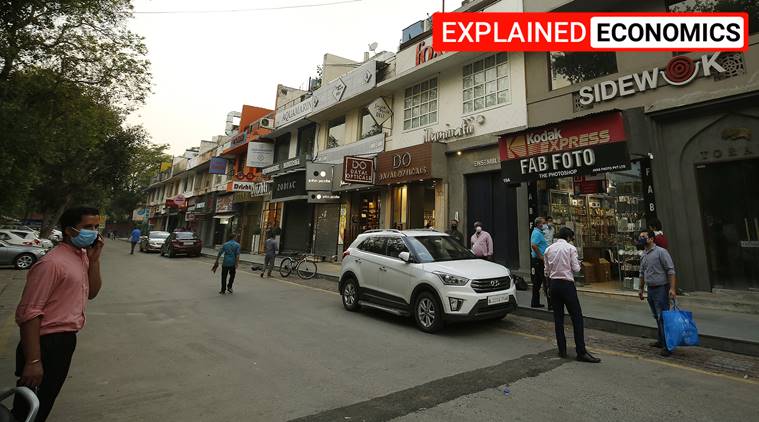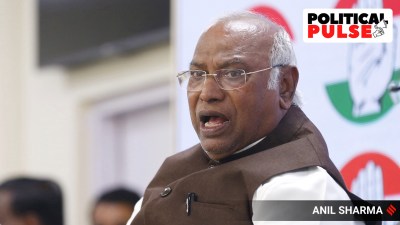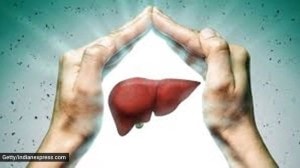- India
- International
Explained: RBI’s new loan recast scheme
The RBI has cleared a loan restructuring scheme for borrowers under stress because of the pandemic. How will the scheme work, and what safeguards are in place to prevent misuse?
 The lockdown impacted sectors of the economy such as hospitality, restaurants, and travel especially badly. Several popular establishments in New Delhi’s expensive Khan Market have shut down.
The lockdown impacted sectors of the economy such as hospitality, restaurants, and travel especially badly. Several popular establishments in New Delhi’s expensive Khan Market have shut down.
In its monetary policy review on Thursday, the Reserve Bank of India gave the green signal to a loan restructuring scheme for stressed borrowers. A special window providing one-time loan restructuring to companies and individuals, it will provide relief specifically to those impacted by the Covid-19 pandemic.
Who will benefit from the scheme?
Only those companies and individuals whose loans accounts are in default for not more than 30 days as on March 1, 2020, are eligible for one-time restructuring. For corporate borrowers, banks can invoke a resolution plan till December 31, 2020 and implement it till June 30, 2021. Such loan accounts should continue to be standard till the date of invocation. The one-time restructuring window is available across sectors.
It is expected to provide relief to companies that were servicing loan obligations on time but could have found it difficult after March, as the pandemic affected their revenues. Companies that were already in default for more than 30 days as on March 1, however, cannot avail this facility. Industry sources said this could affect revival plans of companies that were about to regain profitability but got hit when the lockdown was imposed.
For personal loans, the resolution plan can be invoked till December 31, 2020 and will be implemented within 90 days thereafter. This too is for accounts classified as standard, but not in default for more than 30 days as on March 1.
How will it be implemented?
The RBI has set up a five-member expert committee headed by K V Kamath, former Chairman of ICICI Bank, which will make recommendations on the financial parameters required. While the RBI has given the broad contours, the panel will recommend the sector-specific benchmark ranges for such parameters to be factored into each resolution plan for borrowers with an aggregate exposure of Rs 1,500 crore or above at the time of invocation. The committee will also undertake a process validation of resolution plans for accounts above a specified threshold. The RBI will notify this along with modifications in 30 days. This means the RBI will have the last word on who will be eligible and the parameters.

According to the RBI’s systemic risk survey, the three sectors most adversely affected by the pandemic are tourism and hospitality, construction and real estate, and aviation.
How will the scheme impact banks?
The biggest impact will be that banks will be able to check the rise in non-performing assets (NPAs) to a great extent. However, it will not bring down the NPAs from the present levels; legacy bad loans of close to Rs 9 lakh crore will remain within the system. Banks will have to maintain additional 10% provisions against post-resolution debt, and lenders that do not sign the Inter-Creditor Agreement (ICA) within 30 days of invocation of the plan will have to create a 20% provision. This will be a burden for banks. While a section of borrowers who have gone for a moratorium is likely to apply for the scheme, banks won’t face much of a problem in working out individual resolutions plans: they will have to tackle only borrowers who were in stress after the pandemic hit.
📣 Express Explained is now on Telegram. Click here to join our channel (@ieexplained) and stay updated with the latest
Were earlier such schemes not misused by banks and corporates?
CDR: The RBI discontinued the corporate debt restructuring (CDR) scheme from April 1, 2015. For several years, corporates were misusing the debt recast plans with the regulator turning a blind eye to manipulations by shady promoters in connivance with some banks. Banks also created a separate CDR cell with erstwhile IDBI overseeing the process. The promoters of many big corporates siphoned off bank funds while their units suffered. They approached the CDR Cell and to get their loans recast, some of them more than once. These promoters managed to get fresh loans and they used liberal loan recasts to evergreen their accounts and keep out of the NPA books. Some of them are now in the bankruptcy court.
SDR: Under the Strategic Debt Restructuring (SDR) scheme, banks were given an opportunity to convert the loan amount into 51% of equity which was to be sold to the highest bidder, once the firm became viable. This was unable to help banks resolve their bad loan problem as only two sales have taken place through this measure due to viability issues.
S4A: In the Sustainable Structuring of Stressed Assets (S4A) scheme, banks were unwilling to grant write-downs as there were no incentives to do so, and write-downs of large debtors could exhaust banks’ capital cushions.
 5/25: The 5/25 scheme was derailed because refinancing was done at a higher rate of interest so that banks could preserve the net present value of the loan amount. There was a perception that this was one of the tools deployed to cover NPAs by banks.
5/25: The 5/25 scheme was derailed because refinancing was done at a higher rate of interest so that banks could preserve the net present value of the loan amount. There was a perception that this was one of the tools deployed to cover NPAs by banks.
ARC: In the asset reconstruction scheme, the major problem was that asset reconstruction companies (ARCs) were finding it difficult to resolve assets they had bought from banks. Therefore, they wanted to purchase the loans only on low prices. Consequently, banks were reluctant to sell them loans on a large scale.
IBC: The Insolvency and Bankruptcy Code kicked off; the RBI announced a stringent loan resolution process through its June 7 circular.
Does the new scheme have safeguards against misuse?
Yes, the RBI has built in safeguards in the resolution framework to ensure it does not lead to ever-greening of bad loans as in the past. Restructuring of large exposures will require independent credit evaluation done by rating agencies and a process validation by the Kamath-led expert committee.
Unlike in the case of restructuring of larger corporate exposures, for personal loans there will be no requirement for third party validation by the expert committee, or by credit rating agencies, or need for ICA. The RBI has said that the term of loans under resolution cannot be extended by more than two years. In the case of multiple lenders to a single borrower, banks need to sign an ICA. To mitigate the impact of expected loan losses, banks need to make a 10% provision against such accounts under resolution. For banks not willing to be part of the ICA, a penal provision of 20% has been specified.
What are the major differences with previous recast schemes?
The earlier restructuring schemes did not have any entry barrier, unlike the current scheme that is available only for companies facing Covid-related stress, as identified by the cut-off date of March 1. Strict timelines for invocation of resolution plan and its implementation have been defined in the scheme, unlike in the past when this was largely open-ended. The structuring of the scheme makes signing of the ICA largely mandatory for all lenders once the resolution plans has been majority-voted for, otherwise they face twice the amount of provisioning required. Independent external evaluation, process validation and specific post-resolution monitoring are further safeguards.
Don’t miss from Explained | Why the RBI has left interest rates unchanged
More Explained
EXPRESS OPINION
Apr 19: Latest News
- 01
- 02
- 03
- 04
- 05








































